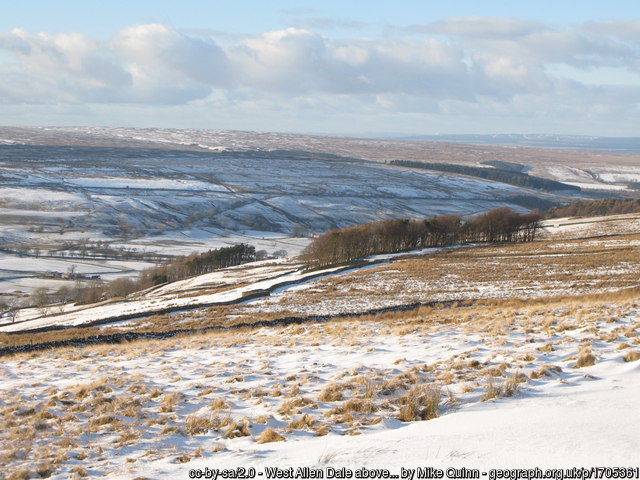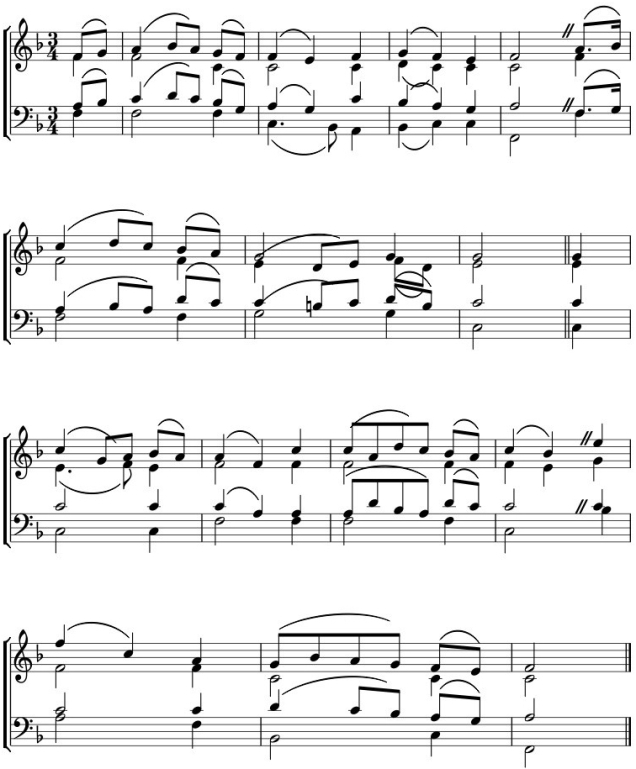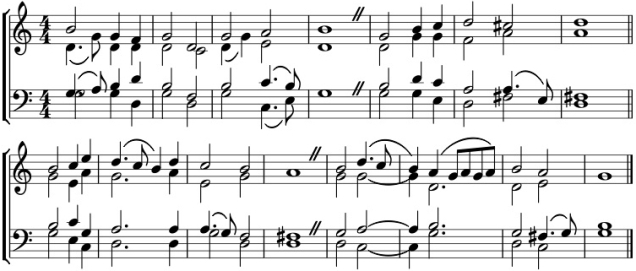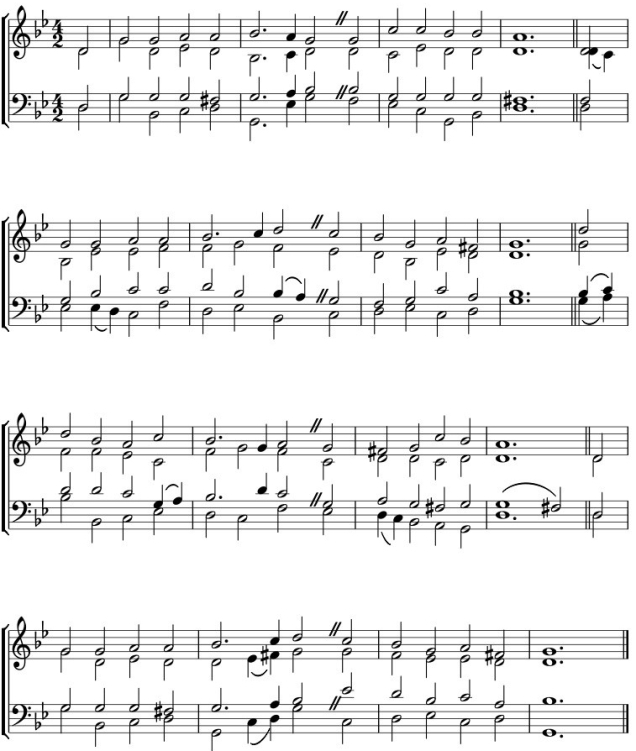
I haven’t posted recently. I have been working on the Second Edition of Books 1-6 and the Tunebook. This has not been progressing very fast.
Meanwhile, though, I thought I would share three tunes. Each of them has something slightly unusual about its history. In each case, also, I have not yet decided to which psalm or canticle to link it. If you have any suggestions for these, please make them in the comments section.
As I am beginning to approach the limit of capacity of my Soundcloud subscription, I have also not yet decided whether to find three existing tunes in the tunebook and on Soundcloud to drop, and if so, which ones. Again, I’d appreciate any suggestions as to ones anyone feels I could drop, or under no circumstances should.
1. Heath – an attractive CM tune
I’ve mentioned Conor Quigley before. He has an interesting webpage, The Psalms of David – Sung a cappella linked to a Soundcloud page with his material. About a year ago he posted what I thought was a really attractive setting of Psalm 23 by the Bon Accord singing group from Trinity Reformed Presbyterian Church, which I think is in Newtownabbey near Carrickfergus in Northern Ireland. The words were the familiar Scottish ones from the Rous psalter of 1650 but the tune was one I had never heard before. He named it as Heath. After I had got back from holiday and had caught up with the backlog of other things waiting for me, I did some research on the internet. The only source that seemed to have any record of a hymn tune called Heath was hymnary.org, which had a few examples from the nineteenth century of what turned out indeed to be the same tune.
This also demonstrates that whoever leads the Bon Accord singing group has a real talent for arrangement. Their version is much better than the original. The way the parts are timed, handled and make their entrances and exits in successive verses has been developed imaginatively. Here is a link to the page with their version.
Next, here is the sheet music, alas, not for theirs but for the simple four part version. It should not be played too fast. Although usually I prefer to ensure that the sheet music line ends coincide with the lines ends in the words, when I tried to compress the music into two lines, the notes became unreadable.

And here is a link to my Soundcloud sample, which compared to the work of Bon Accord does not do justice to the tune’s lyrical potential.
Who composed it?
My research also revealed what I think is an intriguing puzzle. Hymnary.org attributes the tune to Lowell Mason (1792-1872). It even gives it a date of first publication of 1835.
I was puzzled by this. I have been critical of Lowell Mason. I have even described his contribution to hymnody as ‘baleful’. Also, I am no expert on his life. Nevertheless, I find it difficult to believe that he wrote this tune. Neither the tune nor the arrangement – even if that should be from a different hand than the melody – sound or feel to me like his style.
Hymnary.org refers to six instances of the tune, but only reproduces five. It turns out that three out of that five look like reissues of the same or related books between 1886 and 1891. In each case, Heath is for the tune to the Tate and Brady version of Psalm 42, As pants the heart for cooling streams, as abridged by the Revd H. F. Lyte. The attribution to Lowell Mason and the 1835 date comes from those.
The other two instances are from nearly forty years previously, 1841 and 1849, both published in Boston (Mass). In its 1841 appearance, Heath is the tune to the Tate and Brady version of Psalm 23 “The Lord Himself, the mighty Lord, ~ vouchsafes to be my guide”. The 1849 example provides it for an altered version of Isaac Watts’s rendering of Psalm 133. Both differ from the later ones in at least three significant ways. First, both are anonymous, unattributed. Second, as was still not unusual at that date, the melody is in the tenor. What in the later version has become the tenor line, is the counter or boy’s part. Third, the initial quavers are dotted and so are those that come at the beginning of the second line. This is something which in use could be varied between the verses.
What is significant, though, is that Lowell Mason was the editor responsible for the 1841 publication. If he published the tune without attributing it, I think we have to assume that he did not write it and was not claiming to have done so.
The 1849 book has a different editor. Since it was also published in Boston and unattributed, at a time when Lowell Mason was alive and a respected and well known citizen of the city, I think we again have to accept a presumption that in 1849 it was neither attributed to, nor claimed by, Lowell Mason as his own composition.
So, if Lowell Mason did not write it, who did? The tune and what was originally the counter part, but by the 1880s, dropped an octave to become the tenor one, are both fairly ornamental, with several melismas, sometimes but not invariably matching. The alto and bass parts are less florid, carry the rhythm and are harmonically sometimes quite adventurous.
‘Heath’ is not a particularly interesting name. Hymn tunes of that era are often named after places. On it’s own, though, Heath is not that frequent as a place name. Like ‘Common’, it’s more often the second half of a name. So is it just possible it might preserve the name of somebody who wrote it or had something to do with its transmission? I suspect we shall never know and there is no way of finding out. In style, I would suspect it was written sometime in the sixty years before 1841.
2. Taylorburn/Derby?
Over twenty years ago, in a bookshop in Hay-on-Wye, I came across and bought a late eighteenth century prayer book and Tate and Brady psalter. It had clearly once belonged to successive generations of farmers in West Allendale, Northumberland, at least one of whom had played in a church band sometime between 1790 and 1850. It had bound into it lined music sheets on which he had written out the parts he played, usually melody lines. Among them is the ‘air’ part for a tune he has marked as for Psalms 33 and 128. I recently realised it had possibilities. A search of Nicholas Timperley’s Hymn Tune Index at the University of Illinois, http://hymntune.library.uiuc.edu/default.asp revealed this to be Timperley’s tune 2629 and called ‘Derby’. There were records from between 1763 and 1784. I could find no accessible examples from which to extract any of the other parts. I therefore decided to have a go at producing my own four part version. I have made no attempt to replicate the musical style of the time. Here it is,

And here is the Soundcloud sample.
Link to sample of Taylorburn in CM.
Perhaps proper musicians will tell me I am talking nonsense, but it seems to work best if one treats it as modally ambivalent, undecided whether it is in the ordinary Major mode or Mixolydian. I felt it did not work as well when I tried to force it into one mode all the way through. As there are other tunes called Derby I am renaming it Taylorburn in this collection after the address in West Allendale in the psalter.
3. Llangloffan
You may know this tune. It appears in a number of hymn books, usually in G Minor. I had better give an explanation why so far as this collection is concerned, it has a slightly unusual history.
This is because it is invariably listed as 87 87 D. I realised that by making a few alterations to the last bar of the seven syllable lines of the tune, it could fairly easily be converted to Double Common Metre (DCM). in assembling this collection, I have always been on the look out for more DCM tunes. Even with revival of sixteenth and seventeenth century ‘proper’ tunes in that metre, there are not enough of them. Besides, although there are examples in the collection, I find the three and a half feet of seven syllable lines oddly difficult to write to. Does the ‘spare’ syllable come at the beginning of the line or the end? If at the end, is the extra syllable a stressed one, with a gap instead of the unstressed syllable that usually accompanies it, or an extra unstressed syllable requiring a ‘feminine’ ending? If it needs to rhyme, does that force one into two syllable rhymes. I find similar issues arise whether the verse is 87 87, 77 77 or 76 76. Perhaps I have just got too much into the habit of writing in Common Metre or similar, but in each case, although plenty of others have written excellent hymns in these metres, when I try it feels as though there is either an extra syllable that gets in the way, or a syllable that is missing.
Llangloffan appears to be occasionally attributed to a David Evans but he seems to have been the compiler of a Welsh Methodist hymnal Hymnau aThonau of 1865 which may have been its first printed appearance. In Britain it has been linked over the years to a number of 87 87 hymns, some of which have gone out of use or are not well known. It may be better known in the US, as there it seems to be linked to O God of earth and altar, which in Britain is usually sung to King’s Lynn. Llangloffan is in north Pembrokeshire, near Mathry.
So here it is in DCM,

And here is a link to the Soundcloud sample,
4. Downloadable Samples
This is an experiment. I have recently discovered that the Soundcloud help files imply that it is possible to make the sound samples of the tunes downloadable. I have therefore tried to reset them to do this. Please let me know if you can or cannot now download them.
Alas, as far as I can see, it is only possible to download one tune at a time. I haven’t been able to find out if there is a way of making it possible to download either the whole collection or all the tunes in the same metre, all of them at once. If you happen to know a way, please let me know in the comments section below.
5. An extra verse for the Benedicite
The future edition of Book 2 will now include an extra verse in the Benedicite. I had previous left out the reference to Ananias, Azarias and Misael. Unless you know where the Benedicite comes from, that these are the other names for Shadrach, Abednego and Meshach, the three Jewish youths who were thrown in the burning fiery furnace, and that the Benedicite is what they sang in the furnace in the Septuagint account, that verse can be a bit mystifying. However, as it is in the original and the version in the 1662 BCP, in the interests of completeness, there will be an additional penultimate verse, as follows, which will be marked as optional. The diaereses are provided to assist fitting the names to the melody.
Bless the Lord Ananïas, ~ Azarias, Misaël,
Bless the one who’s rescued you ~ from the furnace, fierce and fell.
……….Bless the Lord and sing his praise ~ Exalt him, ever, always.